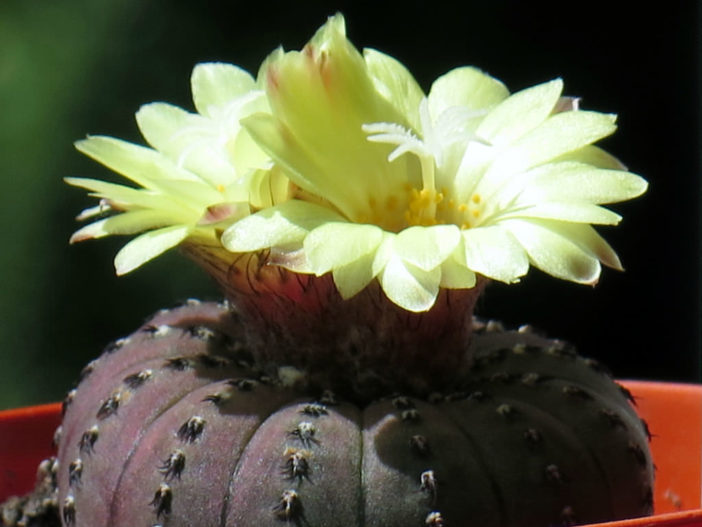Scientific Name
Frailea castanea Backeb.
Synonym(s)
Astrophytum castaneum, Frailea castanea subsp. castanea
Scientific Classification
Family: Cactaceae
Subfamily: Cactoideae
Tribe: Notocacteae
Genus: Frailea
Description
Frailea castanea is a fascinating small cactus with a usually solitary, spherical, apically strongly depressed stem with 8 to 15 distinct ribs lined with areoles with dark hair and clusters of very short spines. The stem is dark reddish-green to chocolate brown and grows up to 2 inches (5 cm) in diameter. Each areole bears 3 to 15 reddish to almost black spines.
The flowers are pale yellow, up to 1.6 inches (4 cm) in diameter, often larger than the stem, and appear in summer. Midafternoon is when you are most likely to find them open.
Origin
Frailea castanea is native to southern Brazil (Rio Grande do Sul), northern Uruguay, and northeastern Argentina. It grows on rocky outcrops at elevations that range from 490 to 980 feet (150 to 300 m).

Hardiness
USDA hardiness zones 10a to 11b: from 30 °F (−1.1 °C) to 50 °F (+10 °C).
How to Grow and Care
Frailea cacti perform best in full sun but be cautious about placing them too close to a southern window where the flesh can burn. The tone of the cactus is darkest when it enjoys a full day of sunlight.
This short-lived plant rarely exceeds 15 years before it dies back. Here is a fun bit of Frailea information. If plants are growing where no water is available, they can hide in the soil. Don't be shocked if your plant seems to have disappeared, as it is retracted under the soil just as it would in the dry season in its native region. Once sufficient moisture is available, the plant swells and is again visible on the top of the soil.
Caring for Frailea is a balancing act between sufficient moisture and periods of soil drying, so water is the biggest challenge in Frailea cactus care. Choose water that is free from heavy minerals. Water well once per week in summer, but water only once every three weeks or when the soil is quite dry to the touch in spring and fall. The plant experiences no growth in winter and does not need water.
Learn more at How to Grow and Care for Frailea.
Links
- Back to genus Frailea
- Succupedia: Browse succulents by Scientific Name, Common Name, Genus, Family, USDA Hardiness Zone, Origin, or cacti by Genus



